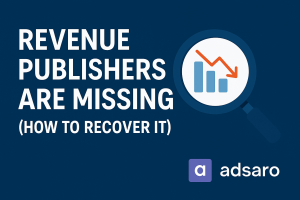In today’s evolving advertising landscape, data privacy concerns are at the forefront. With increasing regulations such as GDPR and CCPA and the phasing out of third-party cookies, advertisers and publishers are looking for innovative ways to continue delivering personalized and effective ads without compromising user privacy. One such solution that has gained traction in recent years is clean room technology in advertising.
Clean room technology allows advertisers and publishers to securely collaborate, sharing valuable insights derived from first-party data without exposing personal data. This has proven to be a game-changer in maintaining privacy compliance while enhancing ad targeting and performance measurement.
In this blog, we’ll dive deep into what clean room technology is, how it works, and its significant impact on the digital advertising ecosystem.
What Is Clean Room Technology?
Clean room technology in advertising is a privacy-focused environment where brands, advertisers, and data providers collaborate. They analyze data together without violating user privacy. In a clean room, data is anonymized through encryption or hashing, protecting personally identifiable information (PII).
This secure environment helps marketers and publishers gain insights from their data, such as customer behavior, conversions, and audience segments, while following privacy regulations. Clean room technology lets advertisers optimize campaigns and make data-driven decisions, even as traditional tracking methods, like cookies, become obsolete.
Why Is Clean Room Technology Important?
With privacy concerns rising and regulations becoming stricter, clean room technology has emerged as a key solution in digital advertising. Here’s why clean room technology is gaining momentum:
- Privacy Regulations Compliance: Laws like GDPR (General Data Protection Regulation) in Europe and CCPA (California Consumer Privacy Act) in the US restrict how advertisers can collect, store, and share user data. Clean rooms allow for secure collaboration between parties while ensuring compliance with these regulations.
- Cookieless Future: The decline of third-party cookies, driven by browser privacy updates and consumer demand for data protection, has made traditional targeting methods less effective. Clean room technology allows advertisers to work with first-party data—data collected directly from consumers with their consent—preserving ad targeting capabilities.
- Secure Data Collaboration: Brands and publishers can combine their data without risking exposure of sensitive or private information. By collaborating in a clean room, they can jointly analyze aggregated insights, such as audience overlap, conversion rates, and ad performance, without ever sharing individual-level data.
- Efficient Ad Measurement: In a post-cookie world, accurate ad measurement and attribution have become more challenging. Clean rooms offer a solution by allowing brands to analyze cross-platform performance and attribute conversions with higher precision while respecting user privacy.
How Does Clean Room Technology Work?
The process of using clean room technology involves several steps that ensure data privacy and compliance while extracting valuable insights. Here’s a breakdown of how it works:
- Data Upload: Advertisers and publishers upload their first-party datasets into the clean room environment. This data could include customer purchase history, website interactions, or campaign performance metrics. The key is that this data is anonymized and stripped of any personally identifiable information (PII).
- Data Matching: Once the data is uploaded, the clean room platform securely matches overlapping data between the different parties involved. This is usually done through hashing (converting data into unreadable strings) or encryption to prevent the exposure of sensitive information.
- Analysis & Insights: The clean room environment allows both parties to run queries and analyze data collaboratively. For example, a brand may want to analyze how their audience overlaps with a publisher’s audience, or they may want to measure how well a particular campaign has performed across multiple platforms.
- Data Export: After the data is processed and analyzed, the results (aggregated insights, not raw data) are exported for further use, such as targeting refined audiences, optimizing campaigns, or measuring cross-channel attribution.
Popular platforms that offer clean room technology include Google Ads Data Hub, Amazon Marketing Cloud, and Snowflake.
Key Benefits of Clean Room Technology in Advertising
Clean room technology provides several advantages that can help improve privacy compliance, ad targeting, and overall campaign effectiveness:
- Privacy Compliance: Clean rooms ensure that all data is anonymized, reducing the risk of violating privacy regulations like GDPR and CCPA. This allows advertisers to operate in a legally compliant manner while still leveraging valuable data for marketing efforts.
- Secure Collaboration: By using clean room technology, advertisers, publishers, and data providers can collaborate more effectively without compromising sensitive data. This opens up opportunities for shared insights without the risks associated with data sharing.
- Advanced Measurement: Clean rooms enable more accurate tracking and performance measurement across various channels and platforms. Advertisers can assess conversion rates, ROI, and audience engagement without relying on third-party cookies or user tracking.
- Audience Segmentation: Clean rooms allow for more sophisticated audience segmentation. By matching overlapping data from different sources, advertisers can build highly targeted audience profiles based on real-world behaviors, making their ad campaigns more effective.
Use Cases for Clean Rooms in Digital Advertising
Clean room technology has numerous use cases in digital advertising, making it an indispensable tool for marketers and publishers. Some key applications include:
- Campaign Measurement: Clean rooms enable advertisers to measure the true effectiveness of their campaigns by analyzing aggregated, cross-platform data. This helps determine ROI and adjust strategies based on real, privacy-safe insights.
- Frequency Capping: By collaborating within a clean room, advertisers and publishers can ensure that users do not see the same ad repeatedly across platforms, leading to a more positive user experience and reduced ad fatigue.
- Lookalike Modeling: Advertisers can use clean room data to identify users who resemble their best customers, without exposing PII. This allows for privacy-compliant lookalike modeling to refine targeting strategies.
- Retail Media Networks: Brands can collaborate with retailers in clean rooms to access valuable retail data and target consumers effectively within walled gardens, ensuring privacy compliance.
Challenges & Considerations
While clean room technology offers numerous benefits, there are a few challenges and considerations to keep in mind:
- Technical Complexity: Setting up and managing a clean room can require advanced data science and engineering skills. Brands and publishers may need specialized resources to properly implement clean room technology.
- Limited Real-Time Data: Most clean room solutions are geared more toward post-campaign analysis rather than real-time bidding or targeting. This can limit their effectiveness in certain high-speed advertising environments.
- Platform Fragmentation: Different platforms offer different clean room capabilities, and there’s a lack of standardization across the industry. This could lead to integration challenges for brands working across multiple platforms.
The Future of Clean Room Technology
As the digital advertising landscape evolves, clean room technology will play a bigger role. With a growing focus on data privacy, consumer consent, and first-party data strategies, clean rooms help brands deliver personalized ads while protecting user data.
Brands and publishers are adopting clean rooms more frequently. They are looking for secure, privacy-compliant methods to collaborate and measure their campaign effectiveness. Clean rooms offer a way to combine valuable data insights without compromising privacy or violating regulations. This shift allows marketers to maintain targeted, personalized advertising efforts while navigating a more privacy-conscious digital world.
Conclusion
Clean room technology in advertising is more than a trend—it’s a vital tool for marketers and publishers in a privacy-first world. It offers a secure, compliant environment for data collaboration. This allows advertisers to deliver targeted, effective campaigns while respecting user privacy. As data privacy regulations tighten and traditional tracking methods become obsolete, clean rooms will play an essential role in digital advertising’s future.
Embracing clean room solutions now ensures compliance with evolving privacy laws. It helps brands gain deeper insights into consumer behavior, optimize ad performance, and build stronger, more personalized customer relationships.








Leave a Reply